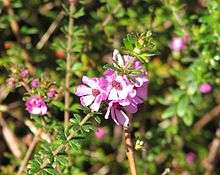Bauera sessiliflora
| Grampians Bauera | |
|---|---|
 | |
| Scientific classification | |
| Kingdom: | Plantae |
| (unranked): | Angiosperms |
| (unranked): | Eudicots |
| (unranked): | Rosids |
| Order: | Oxalidales |
| Family: | Cunoniaceae |
| Genus: | Bauera |
| Species: | B. sessiliflora |
| Binomial name | |
| Bauera sessiliflora F.Muell.[1] | |
Bauera sessiliflora, also known as Grampians Bauera, is a scrambling shrub that is endemic to the Grampians region in Australia.
It grows to between 1–2 metres (3 ft 3 in–6 ft 7 in) in height and has hairy, wiry stems with 6–12 millimetres (0.24–0.47 in) long hairy leaflets. The flowers are stalkless with magenta petals and black anthers. These occur from early spring to early summer, specifically September to December in Australia.
It occurs naturally in sheltered, sandy depressions near streams.
The species was formally described in 1856 by Victorian Government Botanist Ferdinand von Mueller, based on plant material collected at Mount William in the Grampians National Park.[1]
References
- 1 2 "Bauera sessiliflora F.Muell.". Australian Plant Name Index (APNI), IBIS database. Centre for Plant Biodiversity Research, Australian Government.
- Costermans L. (1981) Native Trees and Shrubs of South Eastern Australia, Rigby, Australia.
This article is issued from
Wikipedia.
The text is licensed under Creative Commons - Attribution - Sharealike.
Additional terms may apply for the media files.